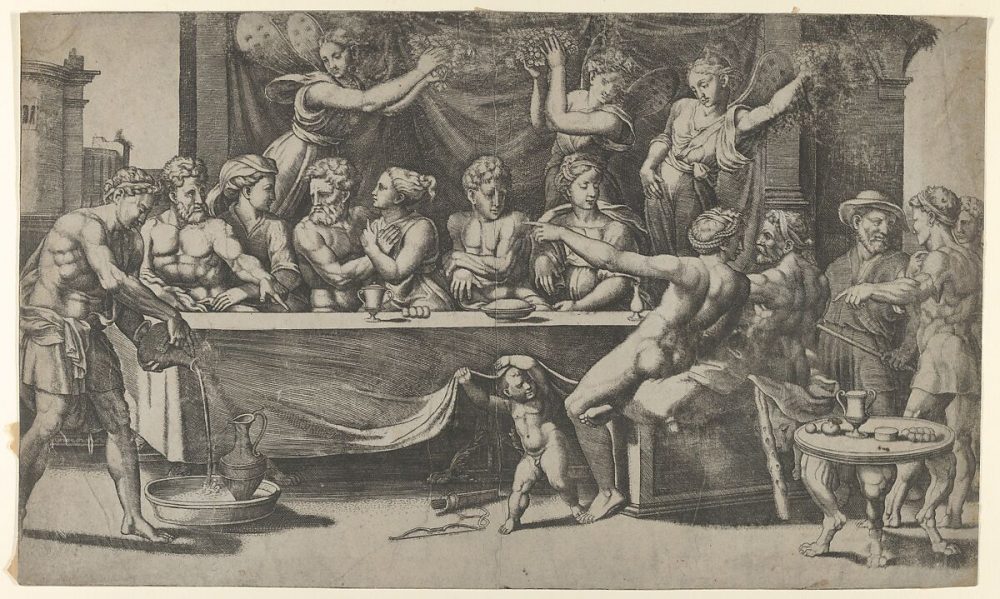
©Metropolitan Museum of Art, New York, www.metmuseum.org
One of the central ideas of the treatise is the division of painting into three different categories. Historical painting (the true), poetic painting (the fictional) and mixed painting (the fabulous). For each of them, different rules and norms apply, which must be observed. Accordingly, many of the mistakes in the art are due to the misidentification of these subjects. As examples, M. Vincenzo mentions various works in Rome. For poetic painting, Raphael’s Feast of the Gods in the Chigi Loggia is mentioned, for historical painting Michelangelo’s frescoes in the papal chapels and for mixed painting in the Palazzo Farnese the works of Giorgio Vasari and Jacopo Salviati.
“M. Vincenzo said: ‘You speak well about this. From the ignorance is born not knowing how to distinguish the true [vero] from the fictional [finto] and the fabulous [favoloso], the poetic from the historical; nor how to distinguish the times, manners, ages, dress, and other qualities appropriate to the figure that they represent. Because it should be understood that the painter sometimes pure historian, sometimes a pure poet [puro poeta], and sometimes a mixture of the two [a le volte è misto]. When he is a pure poet I think it is legitimate for him to paint everything that his own imagination [capriccio] dictates, with those actions and movements, however, that are appropriate to the figures he is representing. We have an example of this in the Chigi loggias where Raphael painted the Feast of the Gods with those actions and movements that he himself invented. We can also describe in this way the loggias of the Pope, done by the pupils of Raphael of Urbino, and also the palace of Pope Julius’s vigna and many other palaces in Rome. Examples of the historical painter [pittore istorico] we have in the old and new papal chapels where we see the old and new Testaments and now the Last Judgement of Michelangelo; also many stories of Saints that are to be found in Roman churches in other places. Of mixed painters [pittore misto] we have the example of the hall in the Cacelleria and the one in the Palazzo Farnese in the Campo de’ Fiori, the former by Giorgio [Vasari] and the latter by Giacopo [sic] Salviati. In these three kinds of painting no one observes what is proper to each, since the poetic painter [pittore poetico] will sometimes invent things that neither do nor can exist, justifying himself without further thought by reference to Horace’s lines:
«poets and painters were always granted equal power and liberty to invent whatever pleases them»’. “
“Disse M. Vincenso: ‘Bene discorrete, e da questa ignoranza nasce il non sapere distinguere il vero dal finto e dal favoloso, il poetico da l’istorico, i tempi, i modi, l’età, i costumi e l’altre qualità convenevoli a le figure che fanno. Perché doverebbono sapere che il pittore a le volte è puro istorico, a le volte puro poeta, et a le volte è misto. Quando è puro poeta, penso che lecito gli sia dipingere tutto quello che il capriccio gli detta, con quei gesti, con quei sforzi sieno però convenevoli a la figura che egli fa: del che abbiamo l’esempio ne le loggie del Chisi, dove Raffaello dipinse la Cena degli Dii con quegli atti e sforzi che il capriccio gli mise in capo. Tal potiamo dire de le loggie del Papa, fatte già dai scolari di Raffaello da Urbino; tal del palazzo de la vigna di Papa Giulio, e di molt’altri palazzi di Roma. Del pittore istorico abbiamo l’esempio de la nova e vecchia Capella del Papa, dove si vede il nuovo e vecchio Testamento, et ultimamente il Giudizio di Michelagnolo, e di molte istorie de’ Santi, che sono ne le chiese di Roma e d’altri luoghi. Del pittore misto abbiamo l’esempio ne la sala de la Cancellaria e nel palazzo de’ Farnesi in campo di Fiore, quella fatta da Giorgio e questo da Giacopo Salviati. In questi tre modi di pingere nissuno osserva il suo decoro conciossia che il pittore poetico a le volte fingerà cose che’ non sono né possono essere, fondandosi senza altra considerazione ne’ versi di Orazio:
«A’ pittori e poeti fu concesso
Equal potere e libertà, di tutto
Quel che gli aggrada poter finger sempre»’.”
Gilio 2018, 100-104, n. 46-53, fig.4-5;



